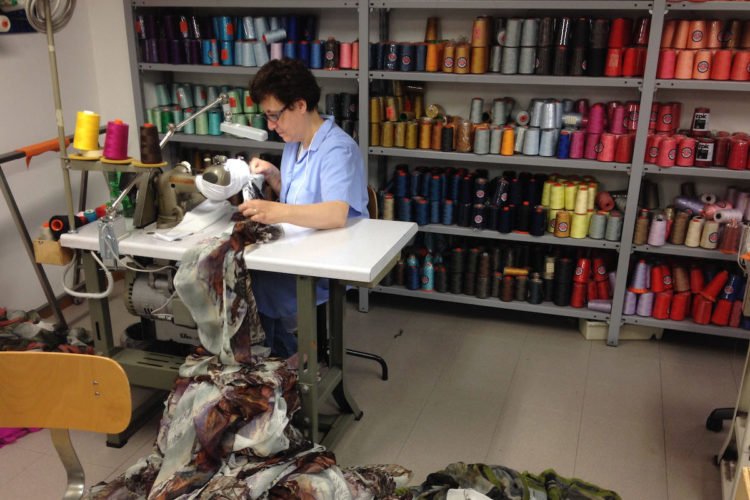my production
Finishing of scarves: hand rolling versus machine rolling

It seems almost like a religion – the hem of a silk scarf should be hand rolled. Is this really so. Yes, it is true that a scarf with hand rolled hems does give a certain feel of sophistication.
strong facts that speak against hand rolling. A job done by women only.
The art of hand rolling takes a lot of skill. Only a woman (we never see men doing this job) with lots of routine can do this job in reasonable time. A scarf that measures 70 x 180 cm has 5 meters of hem plus 4 corners to finish!
very low pay leads to handrolling in cottage industry only
Still, even with lots of routine the pay remains low. That explains why it is a job done by women in cottage industry! Here in Switzerland we can often read that the finishing of the scarves is done in Appenzell – as if this was a guarantee for decent pay.
When I point my finger at the low pay I often get to hear: “well, you see, at least the woman earns SOMETHING otherwise she would earn nothing.” Have we ever heard that kind of argument for any job done by men? no, never!
all of Catherine’s scarves are hemmed by machines
That is why I have my digitally printed silk scarves hemmed by machine. The ladies who work in Roberto’s workshop in the Provincia di Como, Italy, get a regular pay. They work under pleasant working conditions in a space with big windows in a relaxed atmosphere. Working hours are set and the ladies get regular breakes. Comme il faut!
There are regular audits in Roberto’s workshop to assure that the norms are kept.
My scarves with machine rolled hems look perfectly fine and I know that the working ladies take home a good pay.
Nowhere, neither in Switzerland nor Italy nor India does anyone get paid fairly for hand rolling hems. This is simply not possible.
As Roberto says: “il mercato non paga”.
Please think of the ladies who finished the scarves the next time you ask whether a scarf had been hemmed by hand.
producers in Nepal, India, Italy, and Switzerland
The personal exchange as well as knowledge of the production process is essential for Catherine. She has hands-on experience in most textile techniques. That allows her to give input for quality improvements where necessary.
energy consumption, ecology, and ILO standards
Questions regarding the of use of energy, ecology, health hazards to the workers, observing ILO standards are crucial for Catherine. Thanks to her affinity for technology she can give important guidance when it comes to knowledge transfer for solving problems.
